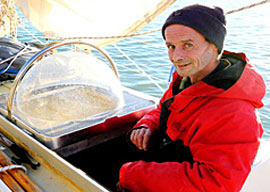
March 21, 2014

Paddy Macklin
On July 1, 1961, a beautiful 17-year-old girl appeared on the cover of Paris Match, back then in its heyday: “C’est une deb,” announced the cover, the once-upon-a-time annual British ritual having passed the Channel to the land of cheese.
Her name was Cristina de Caraman, daughter of the Duke de Caraman, and she was so pretty and angelic-looking that even my mother, who was always after me to marry Greek, told me she was the kind of girl I should get hold of rather permanently. I did so that summer on the Riviera, where her mother’s English family had a house high above Monte Carlo. Cristina’s mother’s maiden name was Macklin, and her brother Lance Macklin was already a hero of mine, being a daredevil racing driver back in the days when a crash meant instant fiery death. Lance had been involved in the 1955 Le Mans accident that caused 84 people to die as Pierre Levegh’s Mercedes had flipped and flown into the stands behind the pits, instantly killing tens and injuring 120. Lance’s Austin-Healey was flying past the pits when Mike Hawthorn’s Jaguar pulled out after refueling. Macklin took avoiding action at a very high speed, but Levegh’s Merc hit Lance’s car and flew into the stands. There were no crash barriers then, and cars caught fire at a bump more often than not. Despite the carnage, the 24-hour race went on, with Mike Hawthorn, the culprit, winning it.
It might sound very brutal now, but the race officials were right to keep it going. Had the race been canceled, thousands would have blocked the tiny roads leading to the track, impeding the ambulances and fire engines from reaching the trapped and the wounded. In any case, there was no culprit; racing was a very dangerous sport and safety measures did not exist. (Sir Jackie Stewart, the man who forced the greedy organizers to install non-flammable gas tanks and collapsing safety-crash barriers, was ten years away.)
This, then, was Cristina’s uncle, and we became fast friends almost immediately. Nada de Caraman and her sister Mia were two English beauties who cut a wide swath in the so-called international set of the 1940s and 50s. I was such a pig back then I made a pass at Nada and was told where to get off rather rudely, but after a while Cristina and I got married because our engagement had lasted too long for polite society. It was not a good enough reason for getting hitched. She was 20 and I was 27, and we partied nonstop for three years, attending every chic ball in Paris, London, and on the Riviera, never staying in a place long enough to collect the laundry—it was done by hand in those halcyon days—Cristina finally deciding my womanizing was not conducive to a stable marriage and children. But I continued to live in her mother’s palatial flat on Avenue Raymond-Poincaré while Cristina left for Mexico for good. That’s when I saw a lot of Lance Macklin, took up polo at his suggestion—he was a top player—and even tried my hand at driving with absolutely zero results.
The reason I am reminiscing more than usual is a book by Lance’s son, Paddy Macklin. He was named after the great Paddy Leigh Fermor and has written about his singlehanded circumnavigation ’round-the-world odyssey in a 27-foot boat. Now, I’ve done my share of dangerous sports—polo, boxing, karate tournaments, and even skiing the front face of a Swiss mountain that is now closed because a fall means instant death—but the idea of going around the world in a 27-foot boat is as alien to me as marrying a male friend. This takes a kind of long-term courage only true heroes have in them. On the spur of a moment, heroics are far easier, such as charging an enemy with a bayonet or jumping out of an airplane yelling “Geronimo,” but leaving dry land with a secondhand satphone bought on eBay, a hand-operated desalination pump, and nothing in the way of navigational aids is slow, agonizing suicide, at least in my book. A long-term heroic takes a very special kind of courage, one the average Joe is incapable of even envisioning.